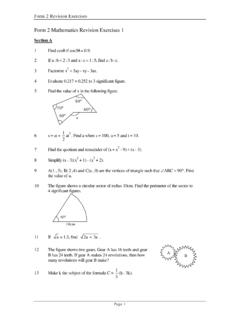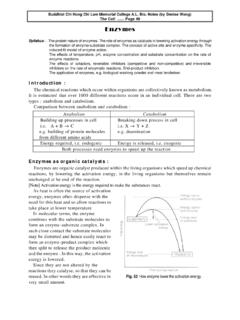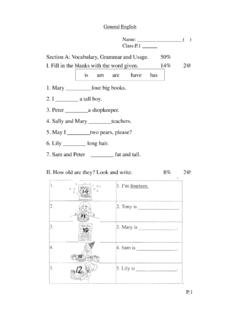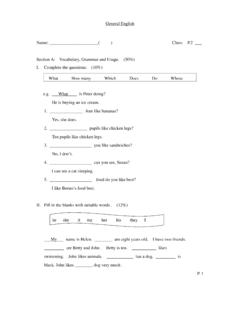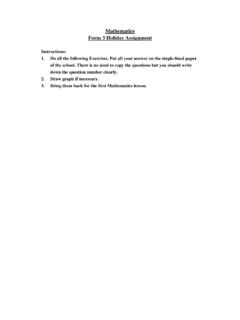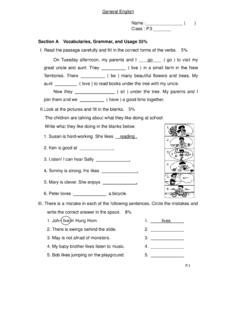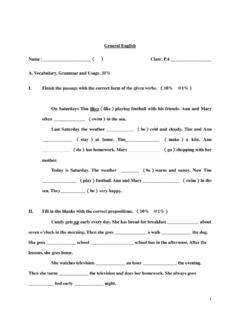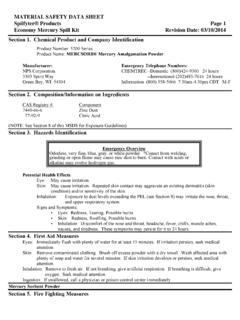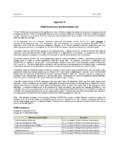Transcription of KIANGSU-CHEKIANG COLLEGE (SHATIN) CSH - …
1 CHEM REVISION EXERCISE Page 1 _____ _____ KIANGSU-CHEKIANG COLLEGE (SHATIN) Revision Exercise (Second Term) Section A : Multiple-choice questions. 1. Which of the following metal oxides will give oxygen on strong heating ? (1) silver oxide (2) mercury(II) oxide (3) copper(II) oxide A. (1) only B. (1) and (2) only C. (2) and (3) only D. (1), (2) and (3) 2. Which of the following is a binary compound ? A. calcium hydride B. zinc nitrate C. ammonium iodide D. sodium hydroxide 3. Metal Y forms a nitride of the formula Y3N2. What is the chemical formula of the dichromate of Y ? A. Y2Cr2O7 B.
2 YCr2O7 C. Y3(Cr2O7)2 D. Y(Cr2O7)2 4. Which of the following is the correct state symbols for the reaction between calcium and water ? A. Ca(s) + 2H2O(l) Ca(OH)2(aq) + H2(g) B. Ca(s) + 2H2O(aq) Ca(OH)2(aq) + H2(g) C. Ca(s) + 2H2O(aq) Ca(OH)2(l) + H2(g) D. Ca(s) + 2H2O(l) Ca(OH)2(l) + H2(g) 5. Which of the following metals CANNOT be extracted by carbon reduction ? (1) zinc (2) lead (3) magnesium A. (2) only B. (3) only C. (1) and (3) only D. (1) and (2) only 6. X, Y and Z are three metals. When heating their oxides alone, only metal Y can be extracted.
3 Metal Z can be produced when adding metal X to the aqueous solution of Z(NO3)2. Arrange the three metals in descending order of reactivity. A. Z, Y, X B. X, Y, Z C. Y, Z, X D. X, Z, Y 7. Which of the following reactions can produce iron ? (1) Heating haematite strongly with aluminium. (2) Adding lead granules into iron(II) sulphate solution. (3) Heating iron(III) oxide strongly with carbon. A. (3) only B. (1) and (2) only C. (1) and (3) only D. (2) and (3) only CHEM REVISION EXERCISE Page 2 _____ _____ Section B : Fill in the blanks. 1. The metal that is used to make light bulb filament is called _____(a)_____.
4 2. Aluminium is passive in the reaction of steam and dilute acid due to the formation of _____(b)_____ on the aluminium surface. 3. The metal _____(c)_____ is extracted from sea water while the metal _____(d)_____ is extracted from limestone. 4. The most abundant metal in the earth crust is _____(e)_____ . Section C : Fill in the table. Chemical name Chemical formula Chemical name Chemical formula silver carbonate 1. 9. NaMnO4 ammonium phosphate 2. 10. CrCl3 mercury(I) sulphide 3. 11. SO3 magnesium nitrite 4. 12. AlH3 manganese(II) chromate 5. 13. FeP nickel(II) bromide 6. 14. Ca(HCO3)2 phosphorus triiodide 7. 15. SiF4 ethanoic acid 8. 16. PbSO3 Section D : Write balanced chemical equations. 1. iron(III) chloride + sodium hydroxide iron(III) hydroxide + sodium chloride 2.
5 Calcium oxide + ammonium chloride ammonia + water + calcium chloride 3. sulphuric acid + potassium hydroxide potassium sulphate + water 4. carbon monoxide + nitrogen monoxide carbon dioxide + nitrogen 5. copper + nitric acid copper(II) nitrate + nitrogen dioxide + water Section E : Answer the questions. 1. Dilute hydrochloric acid is added to a test tube containing an iron nail. On warming, the iron nail dissolves and a colourless gas is evolved. a. State ONE other observation for this reaction. (2 marks) b. Write a balanced chemical equation for the reaction involved. (2 marks) c. Suggest a test for the colourless gas. (1 mark) d. Write a chemical equation for the reaction involved in this test.
6 (2 marks) e. Name a metal that is most suitable to store vinegar. (1 mark) CHEM REVISION EXERCISE Page 3 _____ _____ 2. In an experiment, a student added a piece of magnesium ribbon into an aqueous solution of copper(II) sulphate. a. Name the reaction involved in this experiment. (1 mark) b. Write a balanced chemical equation for the reaction. (2 marks) c. State TWO observations for this reaction. (4 marks) d. If silver is used instead of magnesium, is there any reaction ? Explain. (2 marks) 3. a. What is the flame colour for burning sodium in air ? (1 mark) b. Write a balanced chemical equation for the reaction in (a). (2 marks) 4. a. State TWO observations for the reaction between potassium and water.
7 (4 marks) b. Write a balanced chemical equation for the reaction in (a). (2 marks) c. What will be observed if the resulting solution is tested by a piece of pH paper ? Explain your answer. (3 marks) 5. The years of discovery of metals P, Q and R are given below : Metal P Q R Year of discovery 1827 3000 500 a. Arrange the three metals in descending order of reactivity. (1 mark) b. Explain your answer in (a). (4 marks) c. Name the method that is used to extract metal P from its ores. (1 mark) d. Metal R can be extracted from its oxide ore (R2O3) by carbon reduction. Carbon dioxide is formed during the reaction. Write a balanced chemical equation for the reaction. (2 marks) e.
8 Suggest a chemical test for carbon dioxide gas. (1 mark) f. Write a chemical equation for the test of carbon dioxide. (2 marks) 6. Magnesium can react with steam to form a white powder and hydrogen gas. a. Draw a labelled diagram to show how to do the above experiment in the school laboratory, and to collect the gas product. (4 marks) b. Write a balanced chemical equation for the reaction. (2 marks) c. After the experiment, what safety precaution should be taken ? Explain. (4 marks) ( The End )
